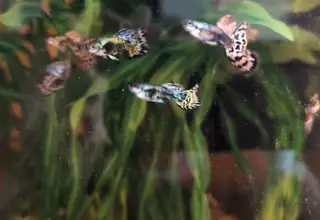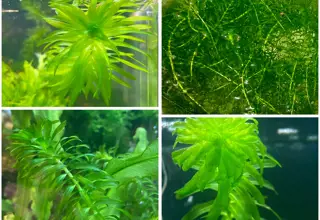Platinum Parrot Fish Care Guide: Size, Diet, Lifespan, Breeding & More
Posted by Miles Harrison on 10/24/2022
We use affiliate links and may receive a small commission on purchases.
The Platinum Parrot Fish is an uncommon and controversial freshwater fish. These fish were bred through a lengthy process of hybridization, and while some hobbyists tend to avoid these fish, others enjoy their comical appearance and curious personalities.
With rumored cichlid ancestry, these fish can be somewhat territorial, but given an adequate tank, these fish can be an absolute joy to watch in a home aquarium!
Although Platinum Parrots aren’t as common as some of the other parrot fish variants, their unique color makes them a favorite amongst aquarists.
If you’re interested in owning one of these fish, we’re going to discuss everything you’ll need to know about the species. We’ll review diet, tank size, lifespan, what to include in their tank, and even discuss breeding!
December's Giveaways on Light Fish
Species Summary
Platinum parrot fish have a fascinating history. Parrot fish are man-made, and it’s not quite clear who the direct ancestors are of these fish. Some suggest parrot fish are a cross between redhead cichlids (Paratheraps synspilum) and convict cichlids (Amatitlania nigrofasciata), while others suggest they are a cross between a cichlid and goldfish.
Platinum parrots are often mischaracterized as Leucistic Convict Cichlids (Amatitlania nigrofasciata), and while they do appear similar, Leucistic Convicts do not have the bird-like face and upturned mouths seen with traditional Parrot Fish.
Whatever your thoughts are on the origin of this species, there’s no doubt that caring for this fish is a fun and rewarding experience. Although there are still some suspicious breeders you’ll want to stay clear of, reputable breeders and sellers are becoming much more common, making it possible to own and care for this species.

Appearance
Platinum Parrot Fish are unique, it’s no surprise that their appearance makes them a popular fish in the aquarium hobby.
Their appearance is largely due to breeding deformities, and while some may consider these deformities to be unsightly, others prize them.
Platinum Parrot Fish have narrow bodies that taper back towards their tail fins. Their pelvic fins, pectoral fins, dorsal, and caudal fins all should have a semi-translucent shade of white, while their bodies and faces should be a uniform opaque white. Platinum Parrots should have a white eyelid that surrounds a black cornea, and the gills and lips of this fish should also appear completely white. The scales of this fish shimmer when under direct lighting, giving the fish a “platinum” appearance.
Parrot fish are unique in that their faces have a round, almost bird-like appearance, and their mouths resemble a Parrot’s beak. While the Platinum Parrot is completely white, other color variations also exist. Variations can be completely solid in color or can have patterns.
Size
Platinum Parrot Fish can grow to be quite large, on average adult Platinum Parrots can grow to be about 6 inches in length. Some fish have even been documented to reach 10 inches!
Since these fish are the result of selective breeding, the best way to determine the size of a juvenile platinum parrot is by knowing the genetic lineage of the fish. Feeding these fish a nutrient-rich diet, and providing them with a stress-free life, will encourage this fish to grow to their fullest potential.
🛒 Shop Freshwater Fish on Light Fish
Platinum Parrot Fish Care
Caring for a Platinum Parrot Fish isn’t very difficult, but you’ll still want to make sure you’re well-versed in knowing how to meet their requirements.
Since this species is a result of selective breeding, there has been a long period of time for aquarists to document and understand the unique challenges this hybrid species presents. Fortunately, parrot fish have been in the aquarium for over 40 years, so there are plenty of resources available to help us make informed decisions when caring for this species.
Lifespan
Given the proper conditions, on average Platinum Parrot Fish can live for up to 15 years in an aquarium. Some aquarists have even reported their fish living for up to 20 years! The life expectancy of this fish is largely related to the life expectancy of the parents. Consider asking your seller or breeder how long the parents of this fish have lived to have some idea of their life expectancy.
Diet and tank conditions are also important. Ensuring that you provide proper water conditions for the duration of the fish’s life will help this fish live its longest.
Tank Size
You’ll want an aquarium that’s at least 30 gallons in size if you plan on keeping Platinum Parrot Fish. Since these fish are quite large, they’ll need plenty of room to swim.
Having a larger aquarium also reduces the chances of potential territory disputes amongst tank inhabitants. Territory disputes are one of the top reasons why hobbyists need to rehome fish, so don’t be afraid to go big when choosing an appropriately sized aquarium for this species.
Water Conditions
Since Platinum Parrot Fish have been bred in captivity for over 40 years, they’re known to be quite hardy and adapt well to most tank conditions.
You’ll want to maintain the following parameters to give your Platinum Parrots the best quality of life possible.
Temperature Range: 73°F-80°F
pH Range: 6.0–7.5
KH: 3-8 DKH
You can monitor water parameters by purchasing a water testing kit Periodically testing your water, and performing bi-weekly 50% water changes, will prevent issues, such as ammonia spikes from occurring.
Tank Setup
Typically it’s best to recreate the natural habitat of your aquarium fish. Since Platinum Parrot Fish do not exist in the wild, we can try to mimic the environment of a likely relative, the Convict Cichlid.
Convict Cichlids can be found swimming in the rivers and lakes of Central America, where there is an abundance of naturally occurring plant life.
Consider adding rocks, stones, and live plants to give your Platinum Parrots a more natural living situation.
Once settled, platinum parrot fish are quite active, so you’ll want to make sure they have plenty of room to swim throughout the aquarium. Aquatic plants with a strong root system can be added, such as Hygrophila Salicifolia but avoid ferns such as Java Fern or Anubias Frazeri, as parrot fish will unroot these quite easily.
When added to a new aquarium, platinum parrot fish can be quite timid, to make this transition period a bit less stressful, you can position hardscape, such as driftwood or rocks, to create small caverns or caves.
Although these peaceful fish do not require any additional powerheads, you’ll still need to provide adequate filtration. We strongly recommend an eheim canister filter that’s rated for your aquarium size.
If you live in a colder climate, you’ll also want to add an aquarium heater, and you’ll want to regulate the temperature using an aquarium thermometer . Since relatives of Platinum Parrot Fish live in warmer waters, you’ll want to make sure temperatures don’t dip below 72°F when keeping this species.
Common Diseases
One of the most common diseases that affect platinum parrot fish is white spot disease, commonly known as Ick. In most fish, it’s relatively easy to spot white spot disease. Small lesions that look like small white dots will appear all over the body of the affected fish. Since Platinum Parrots have an all-white coloration, you’ll need to closely examine your fish for this disease.
Typically, white spot disease is often due to weakened immune systems caused by poor water quality. The parasite responsible for this disease naturally occurs in an aquarium, where healthy fish have no problem warding off this disease.
Typically, the number one cause of fin rot is poor water quality. Purchasing a reliable water testing kit is one of the best purchases you can make as a Discus owner. Monitoring ammonia and nitrite levels to be sure that they never exceed 0ppm is a surefire way to prevent this bacterial infection from taking hold.
Treatment involves quarantining the affected fish for 1-2 weeks and fixing any water quality issues in the aquarium. Perform 40% water changes every 2-3 days until you can achieve optimal water parameters. Hobbyists have also had success with curing this disease by using Hikari Ich-X.
Another common disease is swim bladder disease. Typically fish that experience this disease will swim in odd patterns, and it’s believed to be caused by rapid eating or overfeeding.
When feeding Platinum Parrot Fish, make sure you’re only feeding enough that they can consume within 2 minutes. Treatment typically includes fasting the fish for 4 days and then feeding the fish a skinned pea. Continue to feed the fish a skinned pea daily for an additional 4 days until conditions start to improve.
The best treatment is always prevention. The most common diseases that affect Platinum Parrot Fish can all be avoided by maintaining pristine water conditions. Always test your water frequently to make sure your levels are in balance!
Food & Diet
Platinum Parrot Fish typically have triangular-shaped mouths, which makes scooping the preferred method of eating, rather than biting.
You’ll want to feed Platinum Parrot Fish nutrient-rich floating pellets or mini pellets that will remain on the surface. Brands such as Hikari have developed floating pellets specifically for Parrot Fish that can also be used.
Thawed Bloodworms can also be fed as an occasional snack, but should be fed sparingly as these contain fewer nutrients compared with pellet food.
🛒 Shop Aquarium Plants Fish on Light Fish
Behavior and Temperament
Platinum Parrot Fish are typically quite peaceful and can co-exist comfortably with other tankmates once they’ve been established in an aquarium.
These fish are very active and swim toward their owners when it comes to feeding time. Platinum Parrots tend to be less aggressive than the more common Blood Parrot Fish. As long as the aquarium provides plenty of room for the fish, you shouldn’t run into many issues with these fish.
Tank Mates
Some of the best tank mates for Platinum Parrot Fish are other Platinum Parrots! But if you’re looking to diversify a bit, most peaceful schooling fish will work well with Platinum Parrots.
Some of our favorite tankmates include:
Some of our favorite tank mates include:
- Cardinal Tetras
- Neon Tetras
- Purple Moscow Guppies
- White Cloud Minnows
- Super Blue Kerri Tetras
You should know that there are species that you should avoid. Larger fish or fish that are known for their aggressive behavior should be avoided.
Stay clear of:
- Galaxy Koi Betta
- Discus
- Electric Blue Jack Dempsey
- Tiger Barbs
- Flowerhorn Cichlids
These fish can easily bully a peaceful fish such as the Platinum Parrot, ultimately stressing your fish which can lead to quality of life issues. Always make sure any new fish you plan on adding are compatible with a Platinum Parrot before adding them to the tank.
Breeding
Breeding Platinum Parrot Fish can be a bit of a challenge due to the hybridization of this species. If you’re fortunate enough to have a male and female Platinum Parrot Fish, there is a good chance the female will lay eggs.
To encourage breeding, increase the tank temperature by a few degrees, and make sure water conditions are optimal. If you notice the midsection of your female platinum parrot fish beginning to swell up, there’s a good chance she will soon lay eggs.
Platinum Parrot Fish will become more aggressive during this period, and they will ward off any other tank mates encroaching on their eggs.
Within 4 days, the eggs will hatch into fry. However, due to species hybridization, most males are infertile. Eggs that have an opaque, water fungus are infertile and should be removed if not eaten.
If successful, the platinum parrot fish will mouth brood the fry. Over time, you can begin to introduce crushed flake food and small parts of frozen baby brine shrimp. You’ll also want to perform 25% water changes every other day. Fry are sensitive to sub-optimal water conditions.
If you can raise the fry until they are 6 months old, you’ve successfully bred Platinum Parrot Fish!
Where to Purchase
Hobbyists in the United States looking to pick up a Platinum Parrot should visit our marketplace, where you can buy directly from other hobbyists. However, if you still can't find exactly what you're looking for, we built a massive list of over 250+ online aquarium stores where you can shop for freshwater fish, such as the Platinum Parrot online.
Best of all, you can search the list by shipping origin, so you can find online aquarium stores that ship in your area.
In Conclusion
Platinum Parrot Fish have a unique history, if you choose to purchase this fish, we guarantee you’ll love their playful personalities and peaceful temperament. These fish are a joy to watch, and easy to care for, their platinum coloration makes them truly stand out in a freshwater aquarium!
We hope you’ve enjoyed reading this care guide, and we’d love to hear from you! Consider introducing yourself on our community forum where we discuss more aquarium-related content.
December's Giveaways on Light Fish














